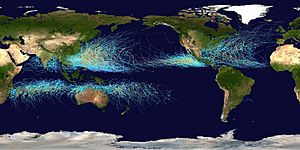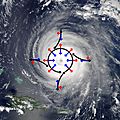Tropical cyclogenesis facts for kids
Tropical cyclogenesis is a scientific term that describes how tropical cyclones (like hurricanes and typhoons) form and get stronger. It happens when a special type of storm, called a warm-core cyclone, develops in the atmosphere. This storm needs a lot of rising air (called convection) and the right conditions in the air around it.
Every year, about 86 tropical cyclones grow strong enough to be called tropical storms. Out of these, about 47 become hurricanes or typhoons. Around 20 of them become very strong, reaching at least Category 3 on the Saffir–Simpson Hurricane Scale.
Contents
What is a Tropical Cyclone?
A tropical cyclone is a powerful, spinning storm that forms over warm ocean waters. It has a low-pressure center and brings strong winds and heavy rain. These storms are known by different names depending on where they form:
- Hurricanes are found in the Atlantic Ocean and the northeastern Pacific Ocean.
- Typhoons are found in the northwestern Pacific Ocean.
- Cyclones are found in the South Pacific and Indian Ocean.
How Do Tropical Cyclones Form?
For a tropical cyclone to form, several things need to happen in the right way. Think of it like a recipe with specific ingredients:
Warm Ocean Water
Tropical cyclones need very warm ocean water to start. The water needs to be at least 26.5 degrees Celsius (about 80 degrees Fahrenheit) and at least 50 meters (160 feet) deep. This warm water provides the energy for the storm to grow. The heat from the ocean makes the air above it warm and moist.
Moist Air and Rising Air
Once the air above the warm ocean gets warm and moist, it starts to rise. As it rises, the moisture in the air cools and forms clouds and thunderstorms. This process is called convection. The more warm, moist air that rises, the more powerful the thunderstorms become.
Low Wind Shear
Wind shear is when winds blow at different speeds or in different directions at different heights in the atmosphere. For a tropical cyclone to form and get stronger, there needs to be very little wind shear. If there's too much wind shear, it can tear the storm apart before it has a chance to organize.
Distance from the Equator
Tropical cyclones usually form at least 5 degrees away from the Equator. This is because of something called the Coriolis effect. The Coriolis effect is a force caused by the Earth's rotation. It helps the storm spin. Close to the Equator, the Coriolis effect is too weak for a storm to spin properly.
Pre-existing Disturbance
A tropical cyclone usually starts from a pre-existing weather disturbance. This could be a cluster of thunderstorms or a tropical wave. These small disturbances provide the initial spin and rising air needed for the storm to develop.
How Do Tropical Cyclones Get Stronger?
Once a tropical cyclone forms, it can get stronger if the conditions remain favorable. It keeps drawing in warm, moist air from the ocean. This air rises, cools, and releases a lot of heat, which fuels the storm even more. The storm becomes more organized, with a clear eye in the center and strong spiraling bands of thunderstorms.
The strength of a tropical cyclone is measured using the Saffir–Simpson Hurricane Scale. This scale goes from Category 1 to Category 5, with Category 5 being the strongest.
Images for kids
-
Loop of sea surface temperature (SST) anomalies in the Tropical Pacific
-
Depth of 26 °C isotherm on October 1, 2006
-
Schematic representation of flow around a low-pressure area (in this case, Hurricane Isabel) in the Northern hemisphere. The pressure gradient force is represented by blue arrows, the Coriolis acceleration (always perpendicular to the velocity) by red arrows
-
Hurricane Pablo formed in the extreme northeastern Atlantic during the 2019 season.








